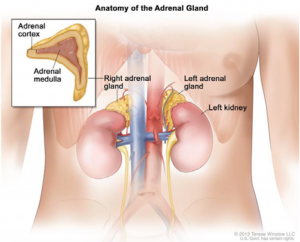11-beta-hydroxylase deficiency, also known as congenital adrenal hyperplasia (CAH), is a rare condition that causes the adrenal glands superior to the kidneys to produce excess hormones. The hormones that are produced in excess are particularly androgens, or male sex hormones. Both females and males normally produce androgens; however, females produce them at a significantly lower level. this disorder, however, can affect both men and women equally.

Males with CAH produce external male genitalia normally, however they are higher levels of androgens. Females, on the other hand, have ambiguous external genitalia, which is a mix of male and female genitalia. Internally,females are normal in terms of female reproductive organs such as ovaries, fallopian tubes, and a uterus. Both males and females often begin puberty at an earlier age than most other children, but growth spurts occur much later in puberty. This causes the growth plats to have a chance to close which prevents individuals with CAH from growing tall. One oddity that occurs within the first year of life in most individuals with 11-beta-hydroxylase deficiency is a increase in blood pressure to the point of high blood pressure.
Congenital adrenal hyperplasia is a condition caused by a genetic mutation where both parents have to pass down the autosomal allele for the child to have the disorder. Research has been conducted in this specific area of disorders and scientists have been able to identify the specific gene responsible for the disorder. CYP11B1 is the mutated gene in individuals with the disorder. With research such as this, a cure is even closer to reality than if the gene was unknown. Since the gene is not a mystery, embryos can be tested for congenital adrenal hyperplasia before they are born. This gives parents the heads up to the condition of the fetus, which can present them with a difficult decision. If they choose to continue with the pregnancy, they realize that the individual will have ambiguous external genitalia, which could inhibit the possibility of predicting the sex of the baby pre-birth.
There are many other symptoms of congenital adrenal hyperplasia than just hypertension within the first year after birth. For the more common symptoms, individuals often have an abnormal rate of hair growth, abnormal menstrual cycles (for females only), decreased circulating renin (regulating blood pressure by changing osmolarity), delays skeletal maturation, and finally enlarged polycystic ovaries (for females only). Although these symptoms might seem manageable, people with congenital adrenal hyperplasia live with the constant thought process of “what if someone finds out the truth about me.” This can be a source of not only anxiety among teens, but also additional stress that is most definitely not needed in individuals. Consider the event of a romantic relationship, especially for the first time. Someone with congenital adrenal hyperplasia would be extremely anxious on what their date would think about them, especially if they are the female.
There is research in progress for CAH, and there is potential for a cure in the near future.